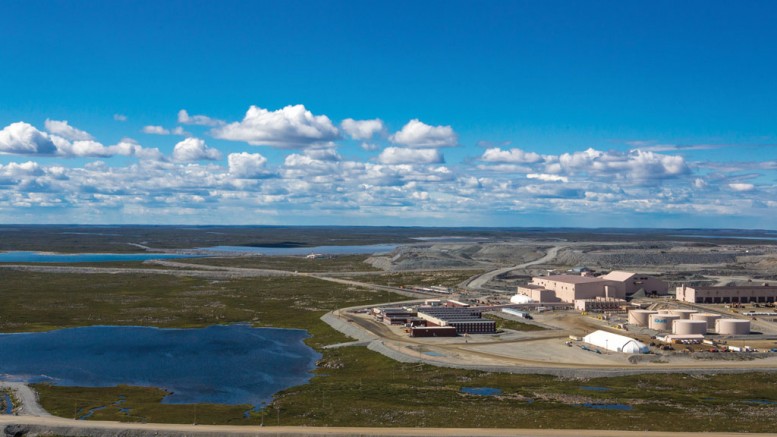Dominion Diamond (TSX: DDC; NYSE: DDC) is going ahead with a major investment to extend by 13 years the mine life at its majority-owned Ekati diamond mine in the Northwest Territories.
The US$647-million investment involves developing the Jay kimberlite pipe deposit, following a recent feasibility study, which should help push Ekati’s mine life to 2033.
The large, high-grade deposit sits beneath Lac du Sauvage — a medium-sized lake north of Lac de Gras — and is about 1.2 km offshore. It benefits from being near existing operations and infrastructure, sitting 7 km from Misery Road and 25 km from the Ekati main camp.
The study forecasts development between 2017 and 2021, assuming final permits are received for the project early next year.
Dominion intends to complete an all-season access road to Lac du Sauvage in 2017, after which it would spend the next three years building a 4.5 km long water retention dyke and more infrastructure to dewater the lake and the area surrounding the pit.
Dewatering and pre-stripping would begin in 2021, followed by first ore production in 2022.
Pleased with the feasibility results, the company’s CEO Brendan Bell said that production from Jay would be well-timed to coincide with a “growing gap in the supply and demand fundamentals of the diamond industry.” The mine extension also creates a “natural platform” for future development, he said.
Dominion aims to fund the project — that US$647 million cost figure includes a US$75-million contingency — using existing cash and future cash flows.
Building the dyke, roads and pumping systems account for half of the start-up capital at US$329 million, with mining equipment being the second most costly item at US$86 million.
The study assumes Dominion will mine the Sable pipe concurrently with Jay until 2023.
Afterwards, all the ore would come from the Jay pit until 2032, with processing ending in 2033.
“With Jay and Sable included in the mine plan, we now forecast the Ekati mine life to run through fiscal year 2034. This 18-year total mine life for Ekati, with steady production from Jay through the latter two-thirds of the plan, provides a stable platform for growth over the long-term,” Elliot Holland, the company’s vice-president of projects, said on the call.
From Jay alone, miners should extract 44.7 million tonnes at a strip ratio of 3-to-1 to produce a total of 78.6 million carats grading 1.8 carats per tonne.
Compared to the 2015 prefeasibility, Jay’s operational mine life has increased by two years to 13, to accommodate the concurrent Sable pipe processing.
However, the feasibility study forecasts recovering 7% less carats at a lower grade, largely due to new bulk sample data and reinterpretating the bulk samples.
It also incorporates a lower base-case diamond price of US$53 per carat compared to US$64 per carat, due to the new sampling data and the November 2015 price book.
These changes have offset the improvements in the mine life, initial capital and strip ratio. As a result, the project economics have decreased.
Using a 7% discount rate and a US$53-per-carat escalating diamond price, which increases 2.5% each year, Jay has a US$398-million post-tax net present value (NPV) and a 15.6% post-tax internal rate of return (IRR), on a 100% basis. In comparison, the prefeasibility study calculated a post-tax NPV and IRR of US$610 million and 16.2%.
“Given this is a brownfield development and considering the positive strategic considerations … It is an investment return that we feel comfortable taking forward to construction,” Holland said. (The economics of Dominion’s share include a US$278-million NPV and 16.7% IRR, after taxes.)
BMO analyst Edward Sterck points out that by eliminating the diamond price escalation, the feasibility study’s after-tax IRR on a 100% basis drops to 6%.
“Jay does not appear to be the most attractive project in the world, which is not a complete surprise,” Sterck said.
He points out that building Jay delays the reclamation liability costs at Ekati by 13 years, which gives the firm enough time to assess other development opportunities.
Along with the feasibility study — released on July 6 — Dominion reported its new capital allocation strategy, noting it would sell its Toronto office building and launch a share buyback program to enhance its annual dividend policy, which is at US40¢.
However, it says it will not change the dividend policy until it knows more about the short-term impacts of the June 23 fire in the Ekati process plant.
A day earlier, it forecasted that the plant repairs would take three months and $25 million, cautioning that both estimates were preliminary. To help lower operating costs during the plant downtime, it has dismissed 330 temporary and permanent contractors and employees for three months, as well as postponed $10 million in non-essential sustaining capital projects to 2018.
Dominion expects Ekati will produce 4.7 million carats in fiscal 2017, down from 5.6 million carats previously.
This month the company’s vice-president group controller Cara Allaway replaces chief financial officer Ron Cameron, until Dominion recruits a new CFO.
“The strategic path forward is sound,” Bell said on the call. “The plan for value creation is crystal-clear … I can say with confidence that the future for Dominion Diamond and its shareholders is indeed very bright.”
Dominion shares closed July 8 at $11.70, within a 52-week range of $9.96 to $17.40.


Be the first to comment on "Dominion approves $647M Jay project"